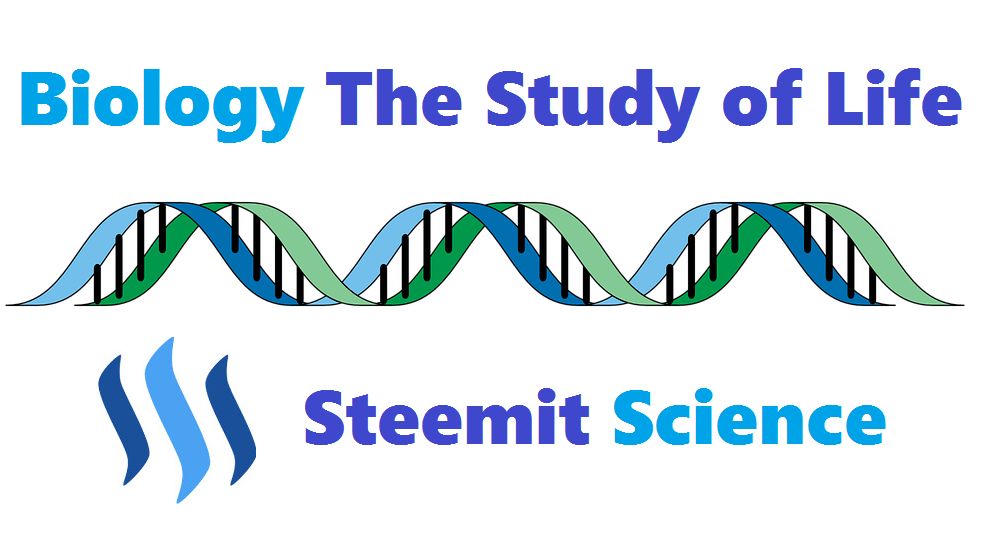
Introduction
This informative series of posts will explore modern biology; the fundamental principles of how living systems work. This material will always be presented at the level of a first-year college biology course, without assuming any prior background in biology or science. It also presents material in a conceptual format. Emphasizing the importance of broad, unifying principles, facts and details in the context of developing an overarching framework. Finally, the series takes a historical approach wherever possible. Explaining how key experiments and observations led to our current state of knowledge and introducing many of the people responsible for creating the modern science of biology.
This post picks up with the hypothesis originally proposed by Watson and Crick for the mechanism by which DNA replicates.

It describes experimental evidence from other researchers that eventually supported this hypothesis and emphasizes the difficulty of inferring molecular mechanisms such as this from observations that can be made in the laboratory. The post goes on to summarize the major features of the process of DNA replication, noting that advances in our understanding of molecular genetics have provided tools now used by researchers to analyze and manipulate the genetic content of cells.
Experiments by Matthew Meselson and Franklin Stahl in the late 1950s supported the semiconservative model of DNA replication, as proposed originally by Watson and Crick.

Testing this model is conceptually simple; simply identify the distribution of newly synthesized DNA compared to the distribution of original DNA after replication. The real difficulty with testing the model lay in developing a new method for labeling or otherwise identifying original and new DNA. Nitrogen is an important chemical constituent of DNA. Meselson and Stahl raised bacteria in growth media enriched either with normal nitrogen (14N) or with a stable, slightly heavier isotope of nitrogen (15N). After many generations of replication, Meselson and Stahl could assume that new DNA synthesized in the normal medium incorporated only normal nitrogen and that new DNA from the 15N medium incorporated only heavy nitrogen. The problem remained, however, of measuring extremely minute differences in the weight of DNA molecules that differed only by the added mass of a single neutron in the heavy isotope of nitrogen. Meselson and Stahl devised a new measurement technique to identify the relative amounts of original and new DNA after replication.
Meselson and Stahl’s new technique was called density gradient centrifugation.
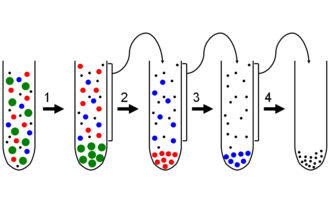
- If the density of a liquid and an object in it are about equal, the object will neither sink nor float but stay at its original depth.
- If there is a range (gradient) of densities in a liquid, denser (heavier) objects will move toward the bottom and less dense (lighter) objects will move toward the top.
- Meselson and Stahl found that a solution of cesium chloride (CsCl) has approximately the same density as DNA. * When they centrifuged tubes of CsCl at very high speeds for long periods, the CsCl formed a density gradient. * DNAs of different densities in such a tube will form bands at their precise densities.
- This technique is sufficiently sensitive to detect the difference between 14N DNA and 15N DNA.
Meselson and Stahl took 15N bacteria, transferred it to 14N growth medium, and waited for it to replicate once.
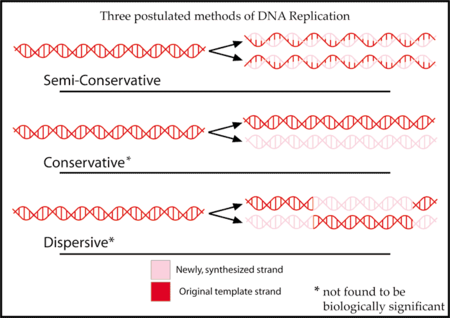
They then extracted the new DNA and measured its density. The distribution of DNA densities following one round of replication ruled out the conservative model, which predicts no mixing of lighter and heavier DNA, but could not distinguish between the dispersive and semiconservative models. After one generation, all the DNA formed one intermediate density band. The distribution of densities following a second round of replication, however, was consistent only with the semiconservative model, which predicts a lighter and a heavier band.
Research by Arthur Kornberg in the 1950s demonstrated that DNA could be synthesized artificially.
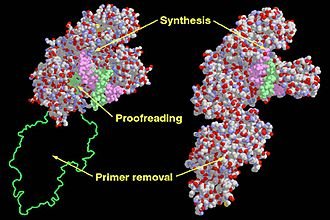
Watson and Crick suggested that complementary base pairing might not even require an enzyme but would, instead, self-assemble new DNA. Kornberg, however, discovered that one protein, DNA polymerase, was in fact the enzyme responsible for DNA polymerization. Decades of subsequent research have identified dozens of other enzymes and molecules that play supporting roles in this complex process.
DNA replication is well understood and easy to conceptualize.

The two strands of the double helix are separated by the enzyme helicase, starting with a small bubble and proceeding outward in both directions. Single-strand binding proteins hold the single strands of DNA open so that they cannot close back into a double helix.
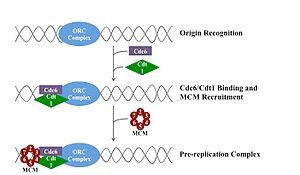
DNA replication starts only at specific sequences of nucleotides, called origins of replication. These origins are different in prokaryotes (single-celled organisms) and eukaryotes (many-celled organisms).
- Prokaryotes have a single, circular strand of DNA, forming a single chromosome with one origin of replication.
- Eukaryotes have multiple, independent strands of DNA (i.e., multiple chromosomes). Each chromosome may have hundreds or thousands of origins of replication.
- Each replication bubble has two Y-shaped regions called replication forks, where the double strand is being separated by helicase.
As the strands separate, DNA polymerase uses each exposed single strand as a template for synthesizing a new complementary strand.

The monomers connected by DNA polymerase are not nucleotides but related compounds called deoxynucleoside triphosphates (dNTPs). Complementary base pairing lines up the correct bases in the correct order for each strand. DNA polymerase uses the energy in the dNTP phosphate groups to bond new bases to new strands. The antiparallel nature of DNA’s two strands means that only one can be transcribed continuously. DNA polymerase can synthesize new DNA only in one direction (it can add only to the 3' end). As a result, synthesis proceeds continuously on the leading strand (5' to 3' direction) but can occur only in short segments on the lagging strand (3' to 5'), because DNA polymerase must work backward there. The segments on the lagging strand are called Okazaki fragments and are eventually stitched together by the enzyme DNA ligase. Understanding DNA replication has been the key to both understanding and manipulating biological systems.
Meselson and Stahl, Kornberg, and other early molecular biologists could never actually “see” a molecule of DNA, yet they worked out the mechanisms of DNA replication.
END PART 8
BIOLOGY THE STUDY OF LIFE:
PART 1 INTRODUCTION
PART 2 WHAT IS LIFE
PART 3 ORIGIN OF LIFE
PART 4 CELL TO ORGANISM
PART 5 PROTEINS
PART 6 CODE OF LIFE
PART 7 DOUBLE HELIX
PART 8 REPLICATING DNA
To support high quality educational content, please consider donating.


 or
or  @pjheinz
@pjheinzImage Credits:
ALL IMAGES UNLESS NOTED - Pixabay
CC0 Public Domain
Free for commercial use
No attribution required
